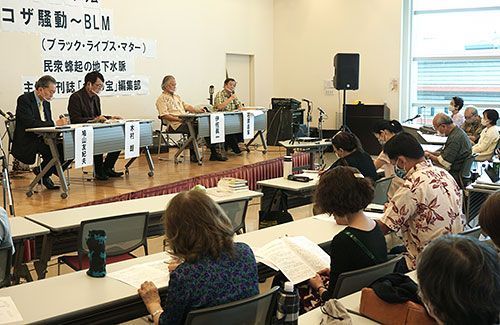“Okinawa’s struggle on the edge of non-violence” discussed at Naha symposium 50 years after Koza riot, links to the present explored

Attendees listening to the speakers at the symposium on November 8 at the Mizu Praça in Naha
November 9, 2020 Ryukyu Shimpo
In light of the upcoming 50th anniversary of the Koza riot on December 20, the editors of the quarterly journal “Nuchi Du Takara” held a symposium at the “Mizu Praça” in Naha titled “The Koza Riot and BLM: Underground Water Veins of Public Uprisings.” Around 60 people attended to listen to the talks and discussion by the panelists.
The panelists were Masaie Ishihara, Shinichi Isa, Akira Kimura, Yukio Hatoyama, Eriko Ikehara, and Shokichi Kina. Ishihara discussed the accidents and crimes by the U.S. military under U.S. rule after the war and changes in popular movements including the island-wide struggle against land expropriation.
Regarding the Koza riot, he said, “I am inclined to define it as a struggle of the people living in Okinawa at the borderline between non-violence and violence, only just keeping on the side of non-violence.”
Isa discussed the historical background from the Ryukyu Disposition to the present, and gave the analysis that “A characteristic of the Koza riot is that it was carried out against both Japan and the United States, and the physical actions involved in the Koza riot have roots connected to those of the direct action at the gate to the base in Henoko, Nago today.”
During the discussion, the panelists talked about such issues as the Koza riot and national security issues surrounding Okinawa. They also discussed the Civil Rights Movement in the 1960s and Black Lives Matter, and sought links between those movements and the Koza riot.
(English translation by T&CT and Sandi Aritza)
Previous Article:With a fighting shout accompanied with Music, Bunshiro Nagamine leads “Radio Karate” at Yaesekotoshien School
Next Article:Video – Bank of the Ryukyus to open main office, built during U.S. control of Okinawa, to the public prior to reconstruction
[Similar Articles]
- “A day of restoring pride as human beings”–naming and present-day significance of Koza riot debated at 50th anniversary symposium
- Photographers discuss significance of Koza riot
- Walking tour around scene of Koza riot to learn about nonviolence
- American activist refers to Okinawa’s reversion to Japanese sovereignty with U.S. military presence intact as “fraud”
- Student researches history of black soldiers’ community in Koza
 Webcam(Kokusai Street)
Webcam(Kokusai Street)


